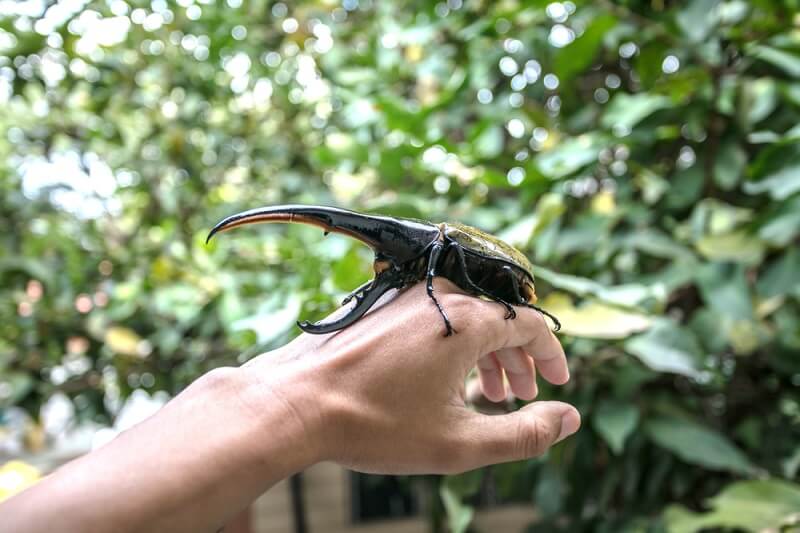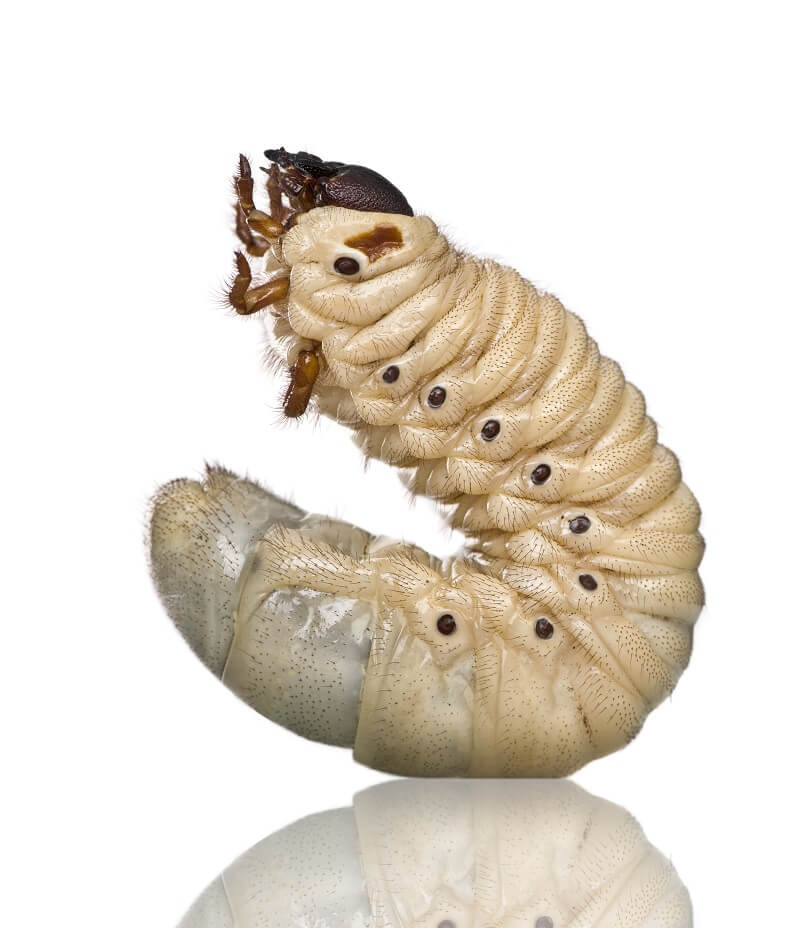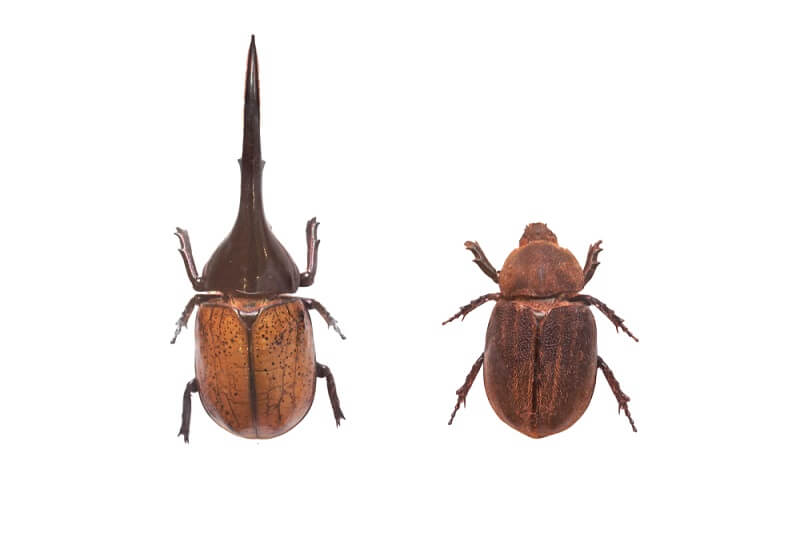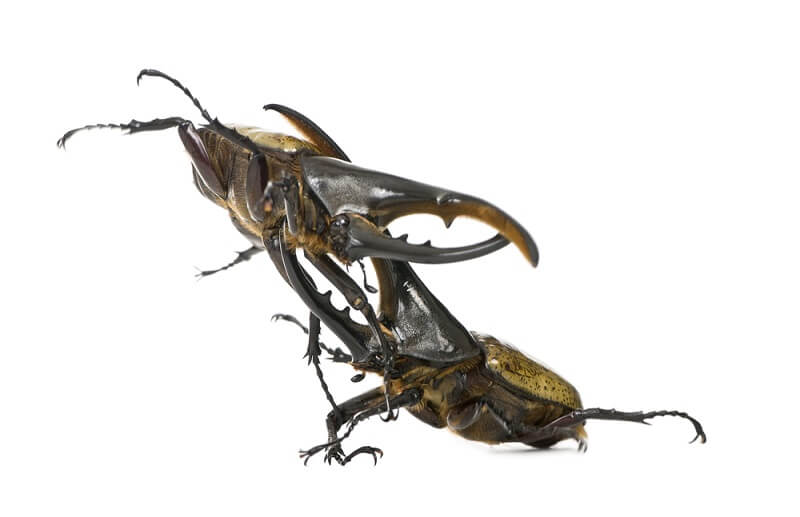
Hercules beetles are among the largest of the Rhinoceros Beetles – found in the subfamily Dynastinae. The Hercules beetles – in the genus Dynastes – are much larger than other rhinoceros beetles. Plus, they can easily be distinguished by the large “pincer” shape of their two horns. Other rhinoceros beetles either have a single horn on their head, or 3+ horns protruding from different areas of the exoskeleton. Hercules beetles can also be distinguished by their large size. Growing up to nearly 3.5 inches, the main Hercules beetle is one of the largest beetle species in the world! Hercules beetles are named for their incredible strength. Normal rhinoceros beetles can carry up to 30 times their mass. Compare this to the Hercules beetle – which can carry up to 850 times its mass – and you will see why these beetles are considered the strongest insects in the world. Like all other beetles, Hercules beetles start life as an egg. Then, they hatch into a larval form (sometimes called a grub) which eats its way into rotting wood. The larvae will eat and grow for over a year before it is ready to pupate. After undergoing metamorphosis as a pupa for 2-3 months, the adult beetle will break out of the old exoskeleton. The beetle will allow its new shell to harden for several hours, before venturing out to find food and a mate. Hercules beetles are sexually dimorphic – only the males have large horns. The males use these large horns to fight each other. Males are attracted chemically and audibly to the females, often drawing more than one male. The two males engage in battle by trying to lift each other. In captivity, this often results in males lifting and slamming each other into the ground until one gets tired. In the wild, these fights may be settled faster. One theory is that because Hercules beetles often fight on tree branches, the first male to be picked up is often dropped off the branch. This ends the fight much quicker and allows the successful male to mate with the female. She will gestate for about a month before she lays up to 100 eggs near a fresh source of rotting wood. There are several different species of Hercules Beetle, each with slightly different characteristics: Hercules Beetle – Dynastes hercules This species of Hercules beetle is native to South and Central America. It is typically found in tropical rain forests with high numbers of woody trees. Since the larvae eat rotting trees, this makes a perfect place for Hercules beetles. The Hercules Beetle is the largest of the Dynastes species. Larvae from this species can fill a person’s hand and can weigh nearly a pound! While the adult beetles lose some weight as they undergo metamorphosis, they can still be nearly 4-inches long and can apply nearly Eastern Hercules Beetle – Dynastes tityus Slightly smaller than the Hercules Beetle, the Eastern Hercules Beetle is native to the Eastern parts of North America. Instead of tropical species, these beetles have adapted to deciduous trees in more temperate regions. Western Hercules Beetle – Dynastes grantii Likewise, the Western Hercules Beetle is also slightly smaller than the South American Hercules Beetle. The Western Hercules Beetle occupies areas of western North America and has become much more adapted to dry climates. Not only do Hercules beetles make for fascinating pets, but they can also demonstrate many different amazing biological concepts! Let’s check out a few of them: Beetles are an excellent example of complete metamorphosis. Organisms that undergo complete metamorphosis completely change the form of their body as they mature from a juvenile to an adult. Hercules beetles start life as a grub and must spend 3 months as a pupa before they can become a sexually-mature adult beetle. Like Hercules beetles, many other insects undergo complete metamorphosis. For example, butterflies form a chrysalis – a type of hanging pupa – as they undergo a complete metamorphosis from a caterpillar to a butterfly. This is also true of moths, flies, bees, ants, wasps, and all other beetles. Any insect that forms a pupa or chrysalis is undergoing complete metamorphosis. By contrast, many other insects undergo incomplete metamorphosis. Insects like grasshoppers, ticks, and spiders typically hatch from the egg with all the major features of the adults. As they grow, they shed their exoskeletons in a series of stages known as instars, nymphs, or juveniles. At a certain size, the insects often develop sexual organs and are able to reproduce. This form of metamorphosis is considered incomplete metamorphosis because the insects remain in a similar form throughout different stages. The entire reason that Hercules beetles make fascinating pets are those massive, intimidating horns seen in male beetles. In many Asian countries and growing parts of the Western Hemisphere, Hercules beetle fights are seen as a form of entertainment. However, since the beetles are fighting outside of their natural environment there is an increased chance that they will be injured. In the wild, the winner is often decided immediately when one beetle gets the upper-hand and unlodges his opponent from a branch. These beetles have wings and can fall great distances without being harmed. The loser simply climbs back into the tree and tries again. In a captive setting, beetles repeatedly pick each other up and get slammed into the ground before one beetle retreats. Considering that a Hercules beetle can exert nearly 30 pounds of force with those pincer-shaped horns, the beetle that loses can sustain life-threatening damage. Hercules Beetles are one of many, many animals that compete for sexual mates. Most often, the males are the ones competing – whether through sound, strength, endurance, or sheer ferocity. In fact, sexual selection is such a strong driving force that it likely helped the Hercules Beetle evolve such monstrous horns. Males with the ability to dislodge other males were given sexual preference, so larger and larger horns were slowly selected for by females over time! Though it may seem odd in some cultures, insects are kept as pets in many parts of the world. Crickets, dragonflies, butterflies, cockroaches, ants, beetles, and almost ever insect imaginable has been kept as a pet. Unlike many wild animals, insects reproduce prolifically. Two wild captive insects can produce an entire line of beetles for the pet trade. Plus, insects make great starter pets for kids. They are easy to take care of, provide opportunities to learn about all different types of biology, and most can be handled safely. Most insects also have a relatively short life cycle, a feature good for kids likely to lose interest in a pet. While it is always important to research any pet you want to get, Hercules Beetles are kept as pets in places as far from their home as Japan. In fact, many Asian countries have a thriving insect pet trade. Hercules beetles are typically reared in plastic containers with species-specific types of wood debris. Over the course of a year or more, the larva develops into an adult. It will remain as an adult for another year or so, and most are easy to handle.
Kingdom
Animalia
Phylum
Arthropoda
Class
Insecta
Order
Coleoptera
Family
Scarabaeidae
Genus
Dynastes
Species
D. hercules, D. tityus, and D. grantii
Niche
Saproxylophagous (feeding on rotting wood) as larvae, herbivorous adults
Length
Up to 3+ in (80mm)
Weight
Up to 5 oz (140g)
Lifespan
34 months (about 18 months spent as larva; 3 months as pupa)
Social Structure
Solitary
Conservation Status
Unknown – though habitat under threat
Preferred Habitat
Tropical Rain Forest of South America, though some species have adapted to dryer habitats in North America
Average Clutch Size
Up to 100 eggs
Main Prey Species
Rotting tropical wood species, fruit
Predators
Birds, bats, small mammals
The Basics

Species of Hercules Beetle
Interesting Insights from the Hercules Beetle!
Complete Metamorphosis

Sexual Competition

Insects as Pets
